2006 FORD F SERIES MOTORHOME AND COMMERCIAL CHASSIS mileage
[x] Cancel search: mileagePage 5 of 128
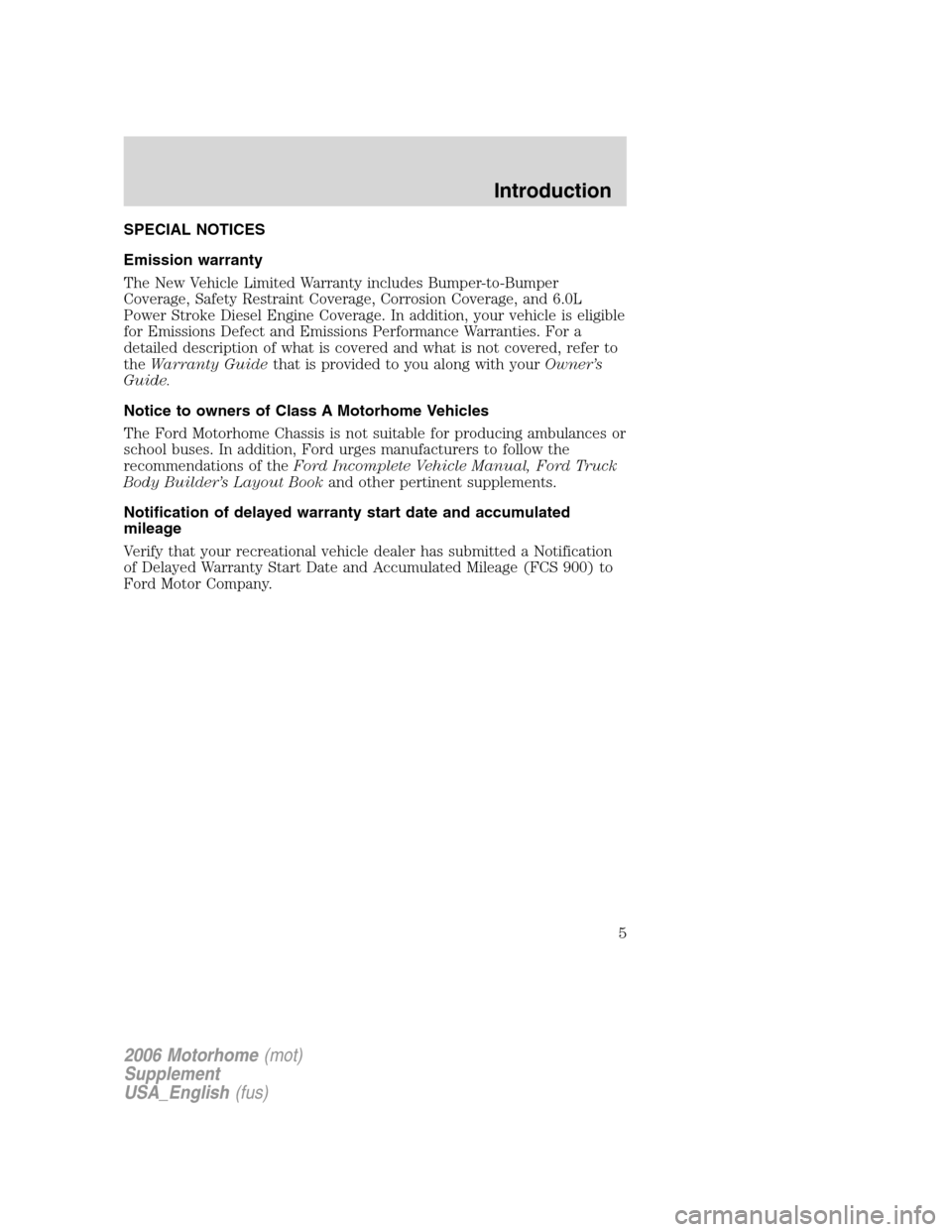
SPECIAL NOTICES
Emission warranty
The New Vehicle Limited Warranty includes Bumper-to-Bumper
Coverage, Safety Restraint Coverage, Corrosion Coverage, and 6.0L
Power Stroke Diesel Engine Coverage. In addition, your vehicle is eligible
for Emissions Defect and Emissions Performance Warranties. For a
detailed description of what is covered and what is not covered, refer to
theWarranty Guidethat is provided to you along with yourOwner’s
Guide.
Notice to owners of Class A Motorhome Vehicles
The Ford Motorhome Chassis is not suitable for producing ambulances or
school buses. In addition, Ford urges manufacturers to follow the
recommendations of theFord Incomplete Vehicle Manual, Ford Truck
Body Builder’s Layout Bookand other pertinent supplements.
Notification of delayed warranty start date and accumulated
mileage
Verify that your recreational vehicle dealer has submitted a Notification
of Delayed Warranty Start Date and Accumulated Mileage (FCS 900) to
Ford Motor Company.
2006 Motorhome(mot)
Supplement
USA_English(fus)
Introduction
5
Page 38 of 128
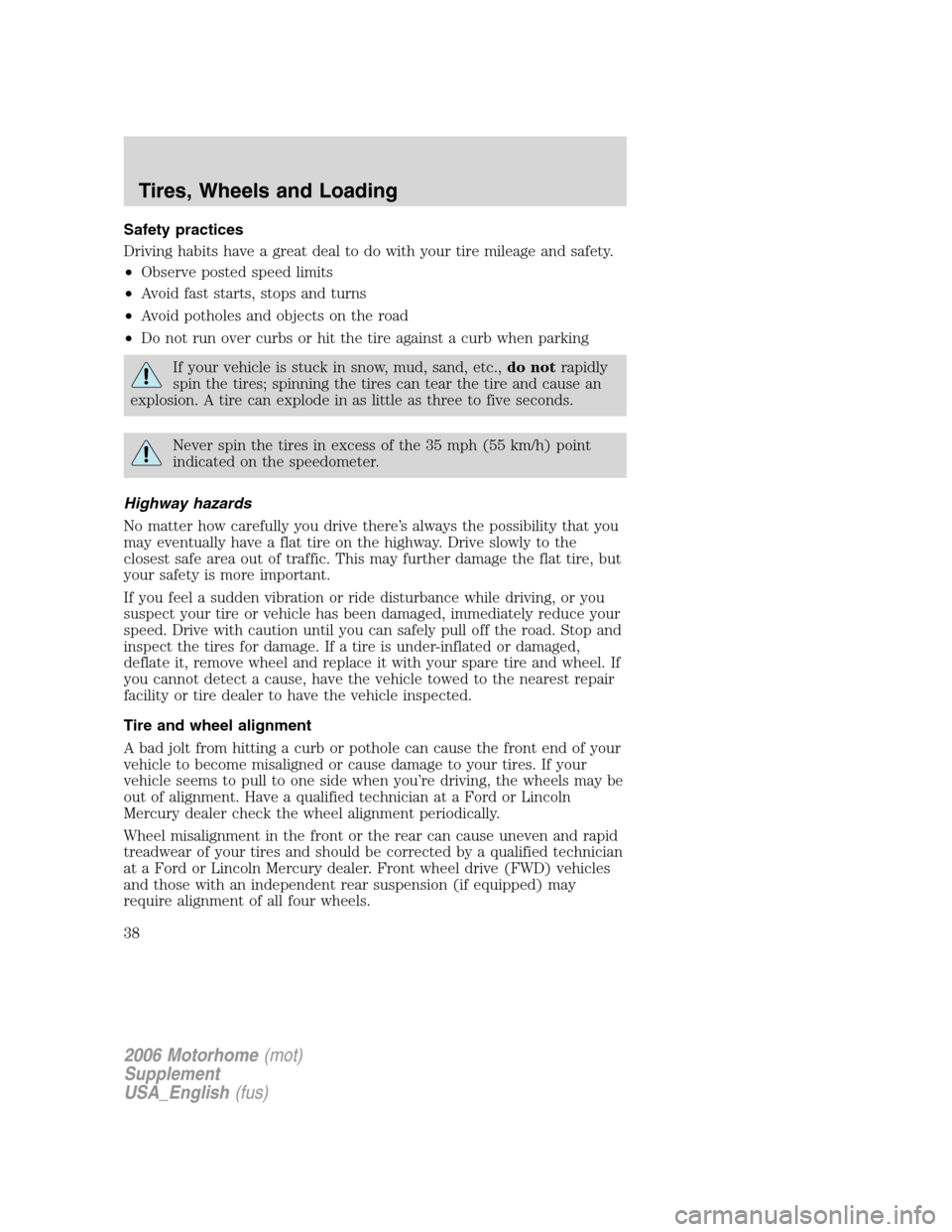
Safety practices
Driving habits have a great deal to do with your tire mileage and safety.
•Observe posted speed limits
•Avoid fast starts, stops and turns
•Avoid potholes and objects on the road
•Do not run over curbs or hit the tire against a curb when parking
If your vehicle is stuck in snow, mud, sand, etc.,do notrapidly
spin the tires; spinning the tires can tear the tire and cause an
explosion. A tire can explode in as little as three to five seconds.
Never spin the tires in excess of the 35 mph (55 km/h) point
indicated on the speedometer.
Highway hazards
No matter how carefully you drive there’s always the possibility that you
may eventually have a flat tire on the highway. Drive slowly to the
closest safe area out of traffic. This may further damage the flat tire, but
your safety is more important.
If you feel a sudden vibration or ride disturbance while driving, or you
suspect your tire or vehicle has been damaged, immediately reduce your
speed. Drive with caution until you can safely pull off the road. Stop and
inspect the tires for damage. If a tire is under-inflated or damaged,
deflate it, remove wheel and replace it with your spare tire and wheel. If
you cannot detect a cause, have the vehicle towed to the nearest repair
facility or tire dealer to have the vehicle inspected.
Tire and wheel alignment
A bad jolt from hitting a curb or pothole can cause the front end of your
vehicle to become misaligned or cause damage to your tires. If your
vehicle seems to pull to one side when you’re driving, the wheels may be
out of alignment. Have a qualified technician at a Ford or Lincoln
Mercury dealer check the wheel alignment periodically.
Wheel misalignment in the front or the rear can cause uneven and rapid
treadwear of your tires and should be corrected by a qualified technician
at a Ford or Lincoln Mercury dealer. Front wheel drive (FWD) vehicles
and those with an independent rear suspension (if equipped) may
require alignment of all four wheels.
2006 Motorhome(mot)
Supplement
USA_English(fus)
Tires, Wheels and Loading
38
Page 81 of 128
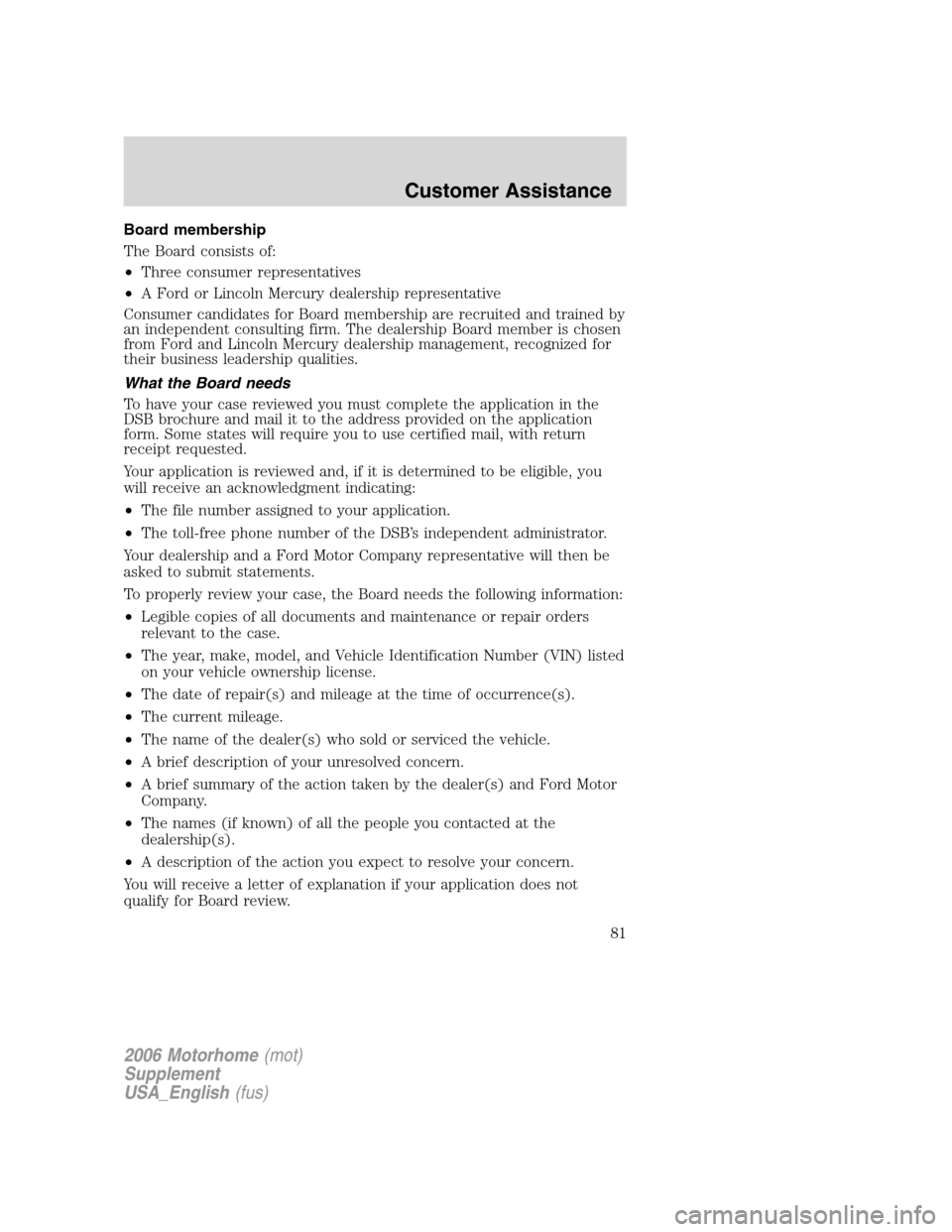
Board membership
The Board consists of:
•Three consumer representatives
•A Ford or Lincoln Mercury dealership representative
Consumer candidates for Board membership are recruited and trained by
an independent consulting firm. The dealership Board member is chosen
from Ford and Lincoln Mercury dealership management, recognized for
their business leadership qualities.
What the Board needs
To have your case reviewed you must complete the application in the
DSB brochure and mail it to the address provided on the application
form. Some states will require you to use certified mail, with return
receipt requested.
Your application is reviewed and, if it is determined to be eligible, you
will receive an acknowledgment indicating:
•The file number assigned to your application.
•The toll-free phone number of the DSB’s independent administrator.
Your dealership and a Ford Motor Company representative will then be
asked to submit statements.
To properly review your case, the Board needs the following information:
•Legible copies of all documents and maintenance or repair orders
relevant to the case.
•The year, make, model, and Vehicle Identification Number (VIN) listed
on your vehicle ownership license.
•The date of repair(s) and mileage at the time of occurrence(s).
•The current mileage.
•The name of the dealer(s) who sold or serviced the vehicle.
•A brief description of your unresolved concern.
•A brief summary of the action taken by the dealer(s) and Ford Motor
Company.
•The names (if known) of all the people you contacted at the
dealership(s).
•A description of the action you expect to resolve your concern.
You will receive a letter of explanation if your application does not
qualify for Board review.
2006 Motorhome(mot)
Supplement
USA_English(fus)
Customer Assistance
81
Page 94 of 128
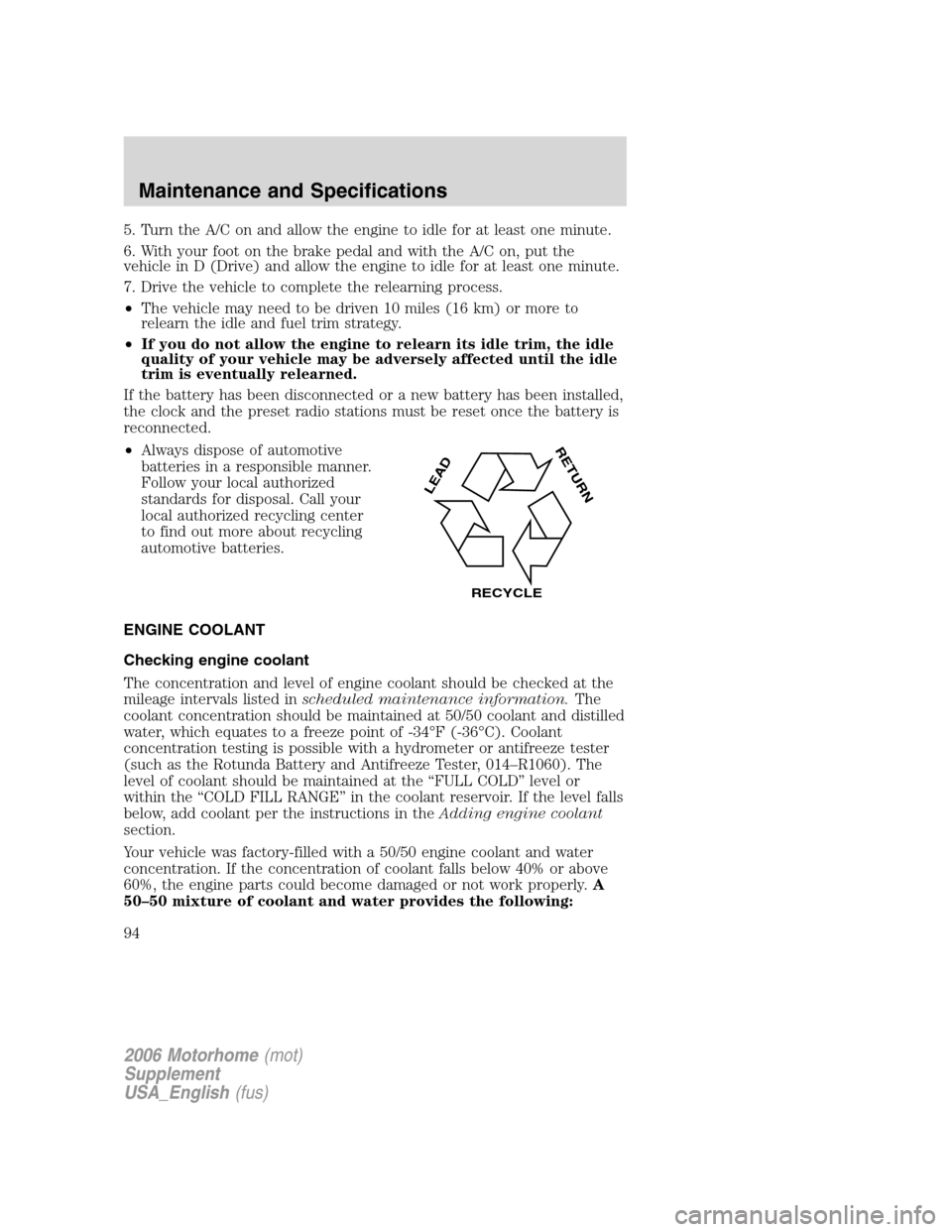
5. Turn the A/C on and allow the engine to idle for at least one minute.
6. With your foot on the brake pedal and with the A/C on, put the
vehicle in D (Drive) and allow the engine to idle for at least one minute.
7. Drive the vehicle to complete the relearning process.
•The vehicle may need to be driven 10 miles (16 km) or more to
relearn the idle and fuel trim strategy.
•If you do not allow the engine to relearn its idle trim, the idle
quality of your vehicle may be adversely affected until the idle
trim is eventually relearned.
If the battery has been disconnected or a new battery has been installed,
the clock and the preset radio stations must be reset once the battery is
reconnected.
•Always dispose of automotive
batteries in a responsible manner.
Follow your local authorized
standards for disposal. Call your
local authorized recycling center
to find out more about recycling
automotive batteries.
ENGINE COOLANT
Checking engine coolant
The concentration and level of engine coolant should be checked at the
mileage intervals listed inscheduled maintenance information.The
coolant concentration should be maintained at 50/50 coolant and distilled
water, which equates to a freeze point of -34°F (-36°C). Coolant
concentration testing is possible with a hydrometer or antifreeze tester
(such as the Rotunda Battery and Antifreeze Tester, 014–R1060). The
level of coolant should be maintained at the “FULL COLD” level or
within the “COLD FILL RANGE” in the coolant reservoir. If the level falls
below, add coolant per the instructions in theAdding engine coolant
section.
Your vehicle was factory-filled with a 50/50 engine coolant and water
concentration. If the concentration of coolant falls below 40% or above
60%, the engine parts could become damaged or not work properly.A
50–50 mixture of coolant and water provides the following:
L
E
A
D
RETURN
RECYCLE
2006 Motorhome(mot)
Supplement
USA_English(fus)
Maintenance and Specifications
94
Page 124 of 128
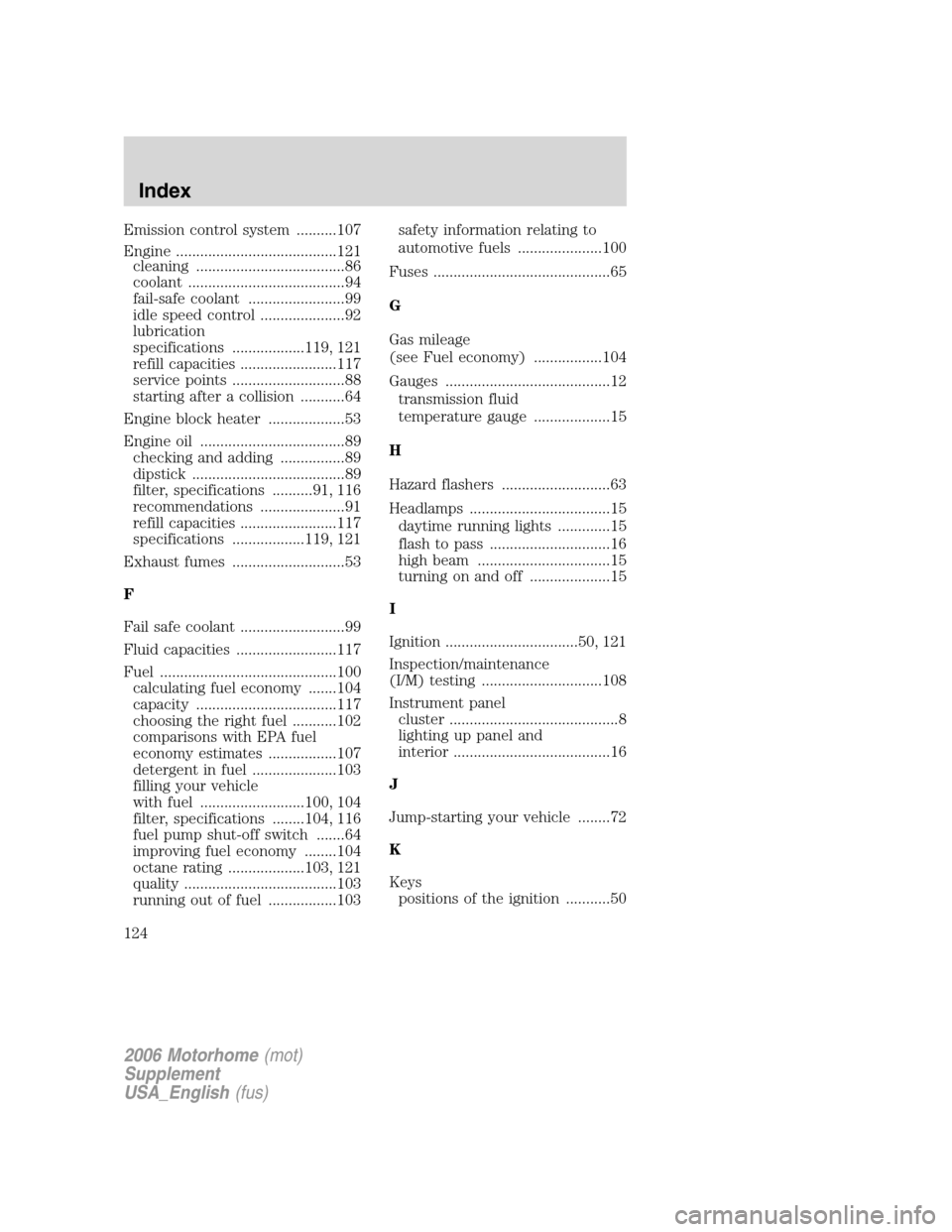
Emission control system ..........107
Engine ........................................121
cleaning .....................................86
coolant .......................................94
fail-safe coolant ........................99
idle speed control .....................92
lubrication
specifications ..................119, 121
refill capacities ........................117
service points ............................88
starting after a collision ...........64
Engine block heater ...................53
Engine oil ....................................89
checking and adding ................89
dipstick ......................................89
filter, specifications ..........91, 116
recommendations .....................91
refill capacities ........................117
specifications ..................119, 121
Exhaust fumes ............................53
F
Fail safe coolant ..........................99
Fluid capacities .........................117
Fuel ............................................100
calculating fuel economy .......104
capacity ...................................117
choosing the right fuel ...........102
comparisons with EPA fuel
economy estimates .................107
detergent in fuel .....................103
filling your vehicle
with fuel ..........................100, 104
filter, specifications ........104, 116
fuel pump shut-off switch .......64
improving fuel economy ........104
octane rating ...................103, 121
quality ......................................103
running out of fuel .................103safety information relating to
automotive fuels .....................100
Fuses ............................................65
G
Gas mileage
(see Fuel economy) .................104
Gauges .........................................12
transmission fluid
temperature gauge ...................15
H
Hazard flashers ...........................63
Headlamps ...................................15
daytime running lights .............15
flash to pass ..............................16
high beam .................................15
turning on and off ....................15
I
Ignition .................................50, 121
Inspection/maintenance
(I/M) testing ..............................108
Instrument panel
cluster ..........................................8
lighting up panel and
interior .......................................16
J
Jump-starting your vehicle ........72
K
Keys
positions of the ignition ...........50
2006 Motorhome(mot)
Supplement
USA_English(fus)
Index
124